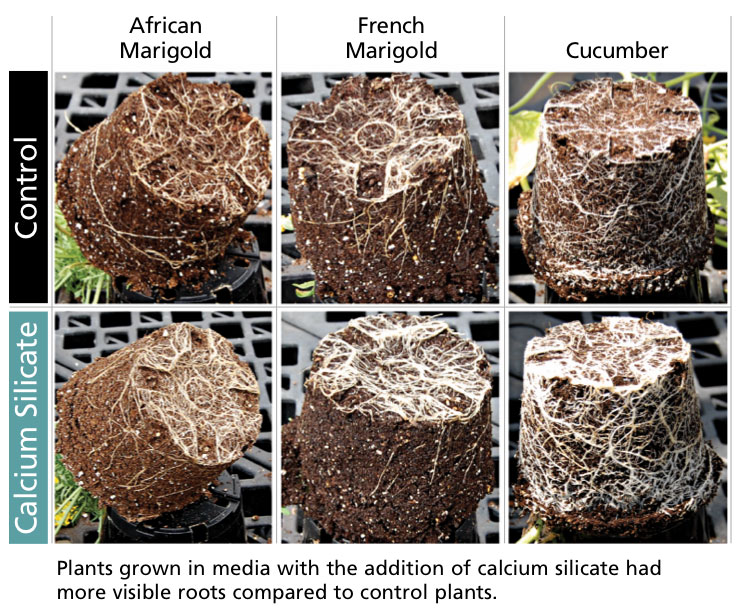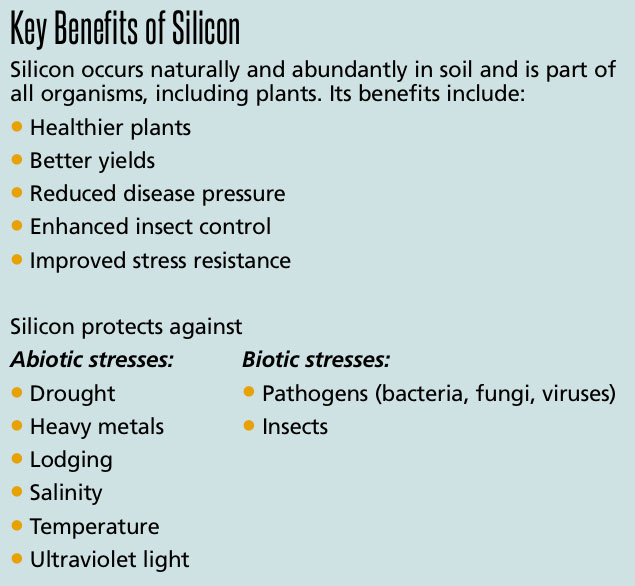2/1/2018
Silicon & Your Fertilizer Program
Dr. Johann Buck
Silicon is not silicone. The plant available form of silicon is silicic acid, Si(OH)4 or H4SiO4, and it’s a key nutrient for plant development. Silicone is a rubber-like polymer used for cookware and lubricants.
While silicon has gained increased attention in the recent past, its role in plant development has remained largely a mystery among the growing public. Part of this is due to the fact that because silicon is so abundant, there are noticeable amounts of silicon from sources such as fertilizers, pesticides, irrigation water and growing media. This prevents researchers from culturing plants in growing media sans silicon. Therefore, it’s difficult to observe any physical evidence of deficiency symptoms or identify developmental roles of silicon.
While developmental roles aren’t widely observed, the beneficial role of silicon on stress protection has been documented in a number of flowering plants. This beneficial response can be attributed to enhanced root development, making silicon a critical part of successful fertilizer programs.
For growers, ensuring plants have the right amount of silicon can be especially important, given that soilless media mixes typically contain little to no available silicon, compared to soils where the element is the second most abundant. While plants absorb silicon differently, its benefits are apparent in all plants, regardless of foliar accumulation.

How does silicon protect plants?
Silicon provides stress-resistance benefits for plants both physiologically and chemically.
On the physical side, silicon thickens cell walls. You can find it in cell layers in both root and foliar tissue. These stronger epidermal layers shield roots from factors such as drought and disease, better positioning plants to withstand adverse environmental stressors. Silicon deposits under the thick cuticle help reduce water loss, and thus help plants better resist drought and water-restricted situations.
Silicon also enhances chemical responses in plants. This includes inducing the reactive oxygen species pathway, part of a plant’s innate defense mechanism—in other words, how plants respond faster to stresses. In addition, silicon stimulates production of phenolic compounds, which protect plants against pathogens, as well as environmental stressors.
When added to growing media, some studies show silicon significantly reduces diseases, such as powdery mildew, and it also reduces mite and insect populations feeding on plants. While silicon won’t cure a plant affected by disease, it will help plants better cope with stresses, such as pathogens, insects, and temperature and water fluctuations. Additionally, the presence of adequate silicon also doesn’t protect against all stress all the time. Plant response can be quite variable and is dependent upon both the plant species and environmental conditions.
Will my crop benefit from silicon?
Silicon is a beneficial plant nutrient widely recognized for its ability to help plants build stronger roots, stems and foliage. Plants absorb at different capacities depending on the species, but all benefit from silicon.
“Silicon’s benefits are apparent in ALL plants, independent of foliar accumulation,” says Dr. Wendy Zellner, a Research Associate Professor at the University of Toledo and one of the country’s foremost silicon researchers.
Plants uptake silicon from soil, thus silicon is most often provided by amending growing media with a silicon product. Plants accumulate silicon in varying amounts, from 0.1% to 15% of their dry weight. While the average uptake is 0.1% to 10%, plants can take up higher concentrations, as well as much lower amounts (<0.01% as seen in some petunia species).
Researchers are still studying how plants transport silicon.
“It’s likely that differences in accumulation come from differences in expression and movement of transport proteins into and out of cellular membranes proteins into the cellular membrane,” says Dr. Zellner.
Being a low-silicon accumulator doesn’t mean that a plant doesn’t need silicon; on the contrary, every plant can gain from this beneficial nutrient. In fact, this is why Dr. Zellner and other researchers are working to change these labels. Low foliar accumulators still absorb silicon higher than other micronutrients. For protection against stress, plants need about 28 ppm of available silicon in the growing media in order to have an effect, regardless of the amount of silicon deposited into its foliar tissue.

Adjusting fertilizer programs for silicon accumulators
Now that you know that plants accumulate silicon differently, do you need to modify your nutrient management program?
Whether you’re producing plants that range from high to low foliar accumulators, you can still feed all with a higher dose of silicon because the nutrient doesn’t have any negative effects at high concentrations. If the concentration of silicon is below 100 ppm silicon, you should be fine. The optimal concentration is about 58 ppm, but this depends on the type of silicon fertilizer that’s being used (i.e., potassium silicate, calcium silicates).
Liquids versus solids will also affect the release rate and concentration of the silicon and likely have slightly different responses.
“That’s the beauty of silicon,” says Dr. Zellner. “Plants will absorb only what they need and there have not been any toxicity symptoms associated with plants within a reasonable silicon range.”
At high concentrations (greater than 1,000 ppm), silicon could tie up micronutrients in the growing media. If the media is already at lower concentrations of these micronutrients, it could cause nutrient deficiency symptoms to appear. Because 1,000 ppm is far greater than the concentrations in average fertility programs, it shouldn’t be a concern.
Silicon can be applied as a soil amendment, liquid fertilizer or foliar spray. In general, concentrations should stay below 75 ppm. Regardless of how plants accumulate silicon, research shows that the nutrient benefits all plants, providing additional stress resilience and enhancing plant growth. GT
Dr. Johann Buck is a plant scientist and Certified Crop Adviser (CCA). He is Director of Sales and Product Development for RainSoil, where he developed the Sitality silicon soil amendment products.